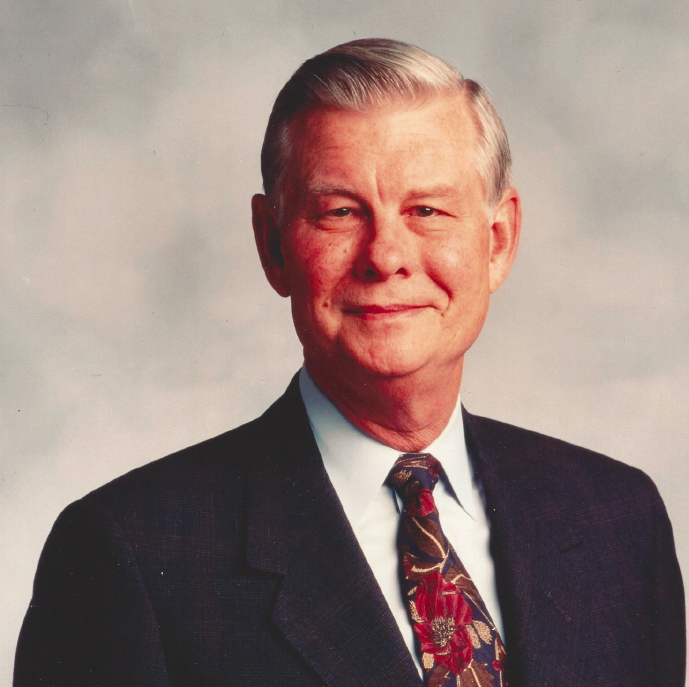
EDWARD E. HOOD JR.
1930–2019
Elected in 1980
“Contributions to the advancement of aircraft engines in efficiency, reliability, and environmental compatibility and the application of the engines to the commercial airline industry.”
BY JAN C. SCHILLING
EDWARD EXUM HOOD JR. died February 3, 2019, at age 88. He was born September 15, 1930, in Zebulon, North Carolina, to Edward Exum and Nellie (née Triplett) Hood. He grew up in Boonville, where he met Kay Transou, his next-door neighbor; she became his high school sweetheart and then his devoted wife of 68 years. He was class valedictorian at Boonville High School and received his undergraduate and master’s degrees in nuclear engineering from North Carolina State University in 1952 and 1953. He then served 3 years in the US Air Force.
Ed began his 36-year career with General Electric as a design engineer in the Flight Propulsion Division in Evendale, Ohio, in 1957. Within 2 years he had begun an extensive optimization study of subsonic turbofan engines, which resulted in quantitative definition of the high-power extraction cycle, a concept that led to a major improvement in subsonic engine performance; he formulated the program of development of components, materials, and manufacturing processes.
His work with nuclear propulsion and new design concepts for gas turbine engines led to his being named head of GE’s Supersonic Transport Project in 1962, when he made the preliminary design of the Mach 2.7 supersonic transport engine (GE4). He planned and implemented the program of development, detailed design, and testing.
In 1968 he was designated company vice president and general manager of the Commercial Engine Division, leading GE’s reentry into the commercial aircraft engine market with the development, certification, and production of the CF6-6 high-bypass turbofan engine for the DC-10 aircraft, the first commercial engine designed to meet specific noise and emission standards. A marine version of the engine powers frigates and destroyers of the US and other navies.
In 1972 he was promoted to vice president and executive of GE’s International Group in Connecticut, and in 1979 he became vice chair and executive officer, a position he held until his retirement in 1993.
Ed was both dedicated to and instrumental in determining the future of GE’s jet engine technology and gas turbine activities, and his knowledge and reputation led to his being named chair of the Aerospace Industries Association board of governors. He also served as vice chair of the National Electrical Manufacturers Association and was an associate fellow of the American Institute of Aeronautics and Astronautics. He remained active after his retirement from General Electric, serving as a director on the boards of Lockheed Martin Corp., Gerber Scientific Inc., Lincoln Electric Company, Martin Marietta Corporation, and Flight Safety International.
In 1988 President Ronald Reagan selected Ed to serve as vice chair (1990–91) of the President’s National Security Telecommunications Advisory Committee.
Ed’s lifelong belief in and appreciation for the importance of higher education were reflected in his philanthropy and volunteerism. In addition to serving on the NCSU Alumni Association board of directors and the university’s board of trustees (1995–2003), he served on the boards of trustees at Rensselaer Polytechnic Institute (1980–95; 10 years as chair) and Lees-McRae College. He and Kay established endowed scholarships at all three schools, helping hundreds of students pursue higher education and achieve personal and professional success. At RPI the couple also established the Edward E. Hood Jr. Endowed Chair of Engineering in 1989
to encourage excellence in education by “recognizing and rewarding an outstanding faculty member.”
Thanks to his selfless work in higher education Ed received two of NC State’s highest honors: the Watauga Medal (2004) and the Menscer Cup (2005). NCSU also conferred on him the 1980 Distinguished Alumnus Award in recognition of his innovative achievements that placed him at the top of one of the nation’s largest corporations. At RPI he was designated chair emeritus in 1995, and at Lees-McRae he was awarded an honorary doctorate of humanities in 2011.
Ed had a lifelong passion for aviation, having gotten his pilot’s license at the age of 15. He loved to take the captain’s seat when traveling on business in GE’s corporate jets, and after retirement owned and piloted several private jets.
Ed will be remembered for his kind and generous spirit, his remarkable intellect, and his philanthropic endeavors.
Kay died January 9, 2020; they are survived by daughters Lisa Bezzeg (Robert) and Molly O’Brian Watkins (David), and six grandchildren.




